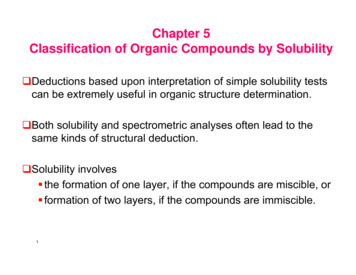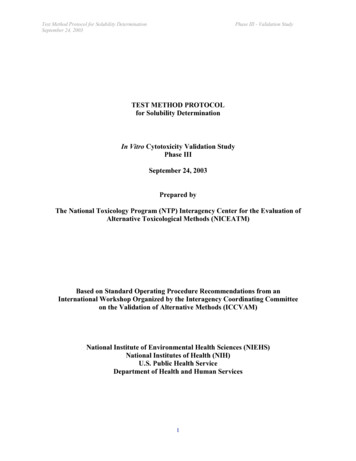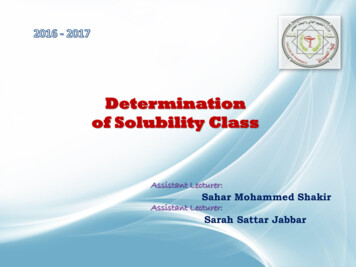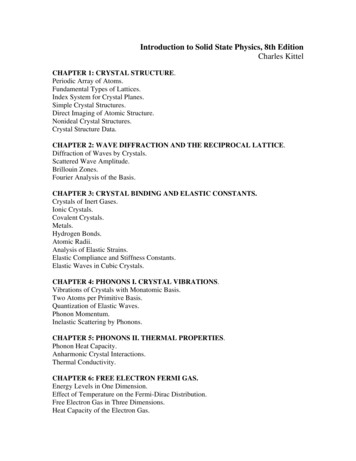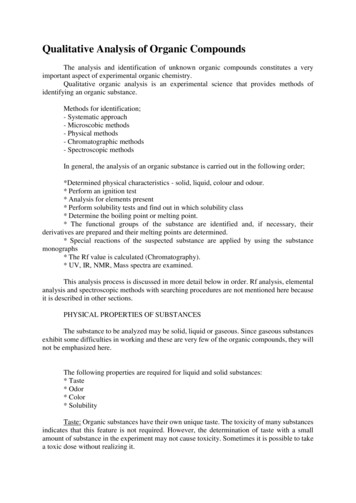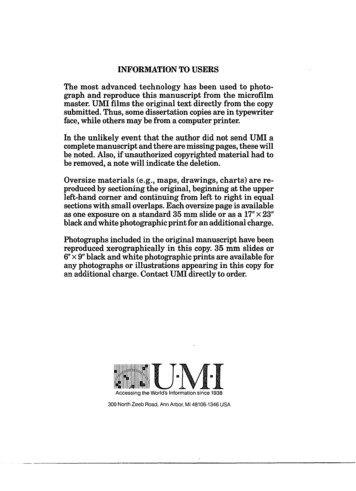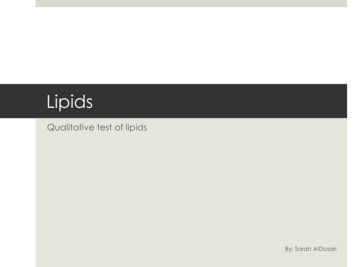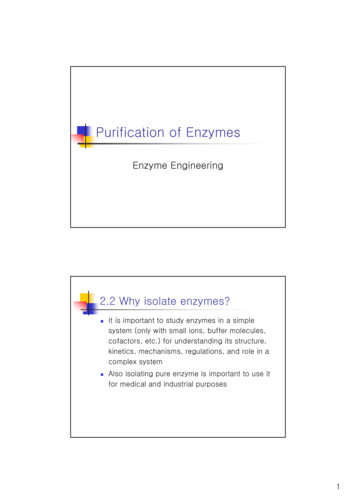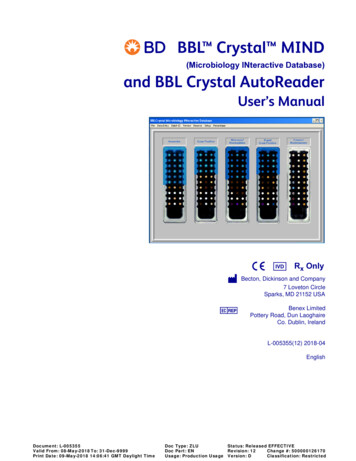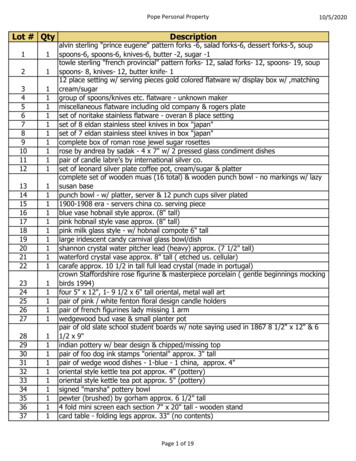
Transcription
Crystal Solubility:Importance, Measurement and MoreProf. Joop H. ter HorstIndustrial CrystallisationEPSRC Centre for Innovative Manufacturing inContinuous Manufacturing and Crystallisation (CMAC)Strathclyde Institute of Pharmacy and BiomedicalSciences (SIPBS)Technology and Innovation CentreUniversity of Strathclyde99 George Street, Glasgow G1 1RD, U.K.Phone: 44 141 548 2858Email: Joop.terHorst@strath.ac.ukwww.strath.ac.uk
Slide 2
Product Complex nPhenomena New level ofunderstanding forpredic/on and controlProcessPharmaceu7cal & ProteinCrystallisa7on Flexible and sustainableproduc/on facili/es
Crystal SolubilityBinary SystemsinPhenanthreneIntermolecular interactionsbetween solute and benzene areessentially identicalBenzeneAnthraceneSlide 4
Crystal SolubilityBinary Systemsx* 20.7 mol%Tm 100 CinPhenanthreneBenzeneIntermolecular interactions inAnthracene crystalare much larger than inPhenanthrene crystal:Anthracene prefers the solid phasex* 0.81 mol%Tm 217 CAnthraceneSlide 5
Crystal SolubilityBinary SystemsinPhenanthreneBenzeneAnthraceneSlide 6Solubility is determinedby intermolecularinteractions in bothsolution and solid
Crystal SolubilityBinary Systems100% pureCrystalline phaseSolution withConcentration C*At temperature T,Pressure PCrystal solubility C*:The solution concentration that is in equilibrium with the crystalline solid at aspecific temperature T and pressure P.Slide 7
Crystal Solubility CrystallizationSolubility MeasurementsSolubility AnalysisSolubility Measurements in ComplexMulticomponent Systems Solubility in Complex MulticomponentSystems Crystallization KineticsSlide 8
Crystallization from SolutionCrystalline product99.99% pureSynthesisof APISlide iningimpurities anddissolvedsynthesisproduct
Crystallization from SolutionsupersaturationProduct al growthsolid formcrystal size distributioncrystal shapepuritySecondary nucleationhydrodynamicsSlide 10Productivity
Crystallization from SolutionSlide 11
Crystallization from SolutionBinary turatedTemperatureSlide 12Heat
Crystallization from SolutionBinary System at constant P,TConcentration C 100 mg/ml solventSolubility C* 20 mg/ml solventYield C-C* 80 mg crystals/ml solvent80% is crystallized,20% remains in solutionThe solubility curve is the first step towards a crystallization process designSlide 13
Crystal Solubility CrystallizationSolubility MeasurementsSolubility AnalysisSolubility Measurements in ComplexMulticomponent Systems Solubility in Complex MulticomponentSystems Crystallization KineticsSlide 14
Crystal Solubility Measurement100% pureCrystalline phaseSolution withConcentration C*At temperature T,Pressure TCrystal solubility C*:The solution concentration that is in equilibrium with the crystalline solid at aspecific temperature T and pressure P.Slide 15
Equilibrium Method Equilibrate suspension atconstant temperature,pressureSample solution & analyzeconcentration HPLC GravimetricConcentra/on Etc.[mg/mL] Accurate Time consumingTemperature [ C]
Temperature Variation MethodClear point temperatureLightXSuspension(Low T)LightClear solution(high T)Clear point temperature:The temperature at which a suspension becomes a clear solutionduring heating with a certain rate
Temperature Variation MethodClear point temperature Increase solubility until suspensionturns into a clear solution Reproducing results fairly quickAlso metastable zone widthTV methodConcentra/on[mg/mL]Change solubilityTemperature [ C]
Clear & Cloud Point MeasurementsClear point, 100% transmissionTs 42.2 CTs 42.3 CHeating rate 0.3 C/minTransmissionT1440 min 1 day
Clear Point & SolubilityConcentration ConstantThermodynamicSaturation temperature If:Crystal detection limit is lowDissolution is fastNo foulingNo crowning Look at the vials!Often, a heating rate of 0.3 C/min gives sufficiently accurate data
Crystal Solubility CrystallizationSolubility MeasurementsSolubility AnalysisSolubility Measurements in ComplexMulticomponent Systems Solubility in Complex MulticomponentSystems Crystallization KineticsSlide 21
Solubility DiagramOf isonicotinamide (INA) in Ethanol
SolubilitySolubility ideal system:Enthalpy of fusion of pure A ΔH 1 1 x* exp R T Tm A exp B T solubilityMelting temperature of pure AFitting the solubility data of a real system:Aln x* BT
Van ‘t Hoff-plotOf isonicotinamide (INA) in EthanolFitting equation:ln x* A BTConvenient andaccurate to extrapolate
Van ‘t Hoff-plotOf isonicotinamide (INA) in EthanolFitting equation:ln x* A BTIdeal solubility:ΔH 1 1 ln x* R T Tm Why is there a difference between ideal and real solubility?
Chemical PotentialIdeal systemµ µ * kT ln xeqeqLeqLReal systemµ µ * kT ln aeqeqLeqLThe activity coefficient γ describes non-idealitya γ x
Crystal Solubility CrystallizationSolubility MeasurementsSolubility AnalysisSolubility Measurements in ComplexMulticomponent Systems Solubility in Complex MulticomponentSystems Crystallization KineticsSlide 27
Co-crystallizationOf isonicotinamide (INA) and Carbamazepine (CBZ) in Ethanol
Pure Component SolubilityOf isonicotinamide (INA) and Carbamazepine (CBZ) in EthanolT 25 CINAx* 33.3 mmol/mol(c* 72 mg/ml)CBZx* 5.7 mmol/mol(c* 24 mg/ml)Solubility of INA is 6 times higher than that of CBZ
Solvent Addition MethodClear point concentrationSuspendedsolid insolventmixture Change the composition untilclear point concentration atconstant temperature Faster than Equilibrium Method Suitable for multicomponentsystems No limitation # components insample and added re [ C]
Solvent Addition Method2x4 Syringe Pumps:Each syringe can hold adifferent solventcomposition.Two different flow ratescan be tested in one go.Crystalline:Slide 318 Reactors withindependent temperaturecontrol and PVM
Co-crystal Phase diagramCarbamazepine (CBZ)Isonicotinamide (INA)Ethanol0.005T 20 ity CBZSolubility INASolubility Cocrystal0.04
Crystal Solubility CrystallizationSolubility MeasurementsSolubility AnalysisSolubility Measurements in ComplexMulticomponent Systems Solubility in Complex MulticomponentSystems Crystallization KineticsSlide 33
Crystal FormForm IForm IIPolymorphism: The ability of a chemical compound to form 2 or more crystalstructuresSlide 34
Crystal FormForm IIForm IConcentra7on!The clear point temperature dependson the polymorph that is present in thesuspensionTemperatureSlide 35
Complex Phase BehaviorTx [w%](Normal)Slide 36Salt, Co-crystal, solvate:The crystal phase mightcontain more componentsin specific ratiosSolid Solution:The crystal phase might containmore components in varying ratiosM. Matsuoka,1978
ChiralityIntroductionenantiomers(S)Slide 37(R)
Chiral compoundsBinary phase diagramConglomerateRacemic compoundSolid solutionThe phasediagram reflectsLL the kind of solid LstateTS LR LS LS RSR SSSlide 38yRRS LR SR LR RSyRR SRSyRR
Chiral Compound SolubilityAsparagine in WaterTernary phase diagram screeningSample composition30Clear point temperaturesax 25x 152580bx 25x 1570Conglomerate20Ts60[ C]15xs[mmol/mol]1050504005101520x R [mmol/mol]253000.250.5y R [-]0.75yR xR/(xR xS)Slide 391
Chiral Compound Solubility:Ibuprofen in HexaneTernary phase diagram screening200cx 17560dRacemic compound5015040xs[mmol/mol]Ts30[ C]10020501000050100x R [mmol/mol]15020000.250.5y R [-]0.75yR xR/(xR xS)Slide 401
Chiral Compound solubility:Atenolol in EthanolTernary phase diagram screening30ex 25x 25x 10x 10605020fx 25x 25x 10x 1040xsSolid solutionTs30[ C][mmol/mol]102010000Slide 411020x R [mmol/mol]3000.250.5y R [-]0.751S. Sukanya, J.H. ter Horst,Racemic Compound, Conglomerate, or Solid Solution: Phase Diagram Screening of Chiral Compounds,Crystal Growth Design 10(4) (2010) 1808-1812.
Crystal Solubility CrystallizationSolubility MeasurementsSolubility AnalysisSolubility Measurements in ComplexMulticomponent Systems Solubility in Complex MulticomponentSystems Crystallization KineticsSlide 42
Metastable Zone Width6010055905080Temperature[ C]70Clear point4060355030MSZWCloud point2520101056:00Transmission40of light[%]30201507:128:249:36Time (hour)10:4812:00Transmissivity (%)Temperature (oC)45
Measuring Induction TimesThe time until detection of crystals at aconstant supersaturation Accurate temperature controlTemperature[oC]6010050754050 Transmission[%]t301 ml2520078910Time [hr]1112
Measuring Induction Times Create constant supersaturation Measure induction time Do this a large number of times, say M timesP (t) M (ti)/MConstant SS. Jiang, J.H. ter Horst, Crystal Growth Design 11 (2011) 256-261
Induction Time DistributionsS 3J 668 m-3s-1J.H. ter Horst, C. Brandel, MeasuringInduction Times and Crystal NucleationRates, Faraday Discuss. 179 (2015) 199S 3J 79 m-3s-1DPL RII from IPADPL RI from DMF
Crystal Solubility CrystallizationSolubility MeasurementsSolubility AnalysisSolubility Measurements in ComplexMulticomponent Systems Solubility in Complex MulticomponentSystems Crystallization KineticsSlide 47
Crystal Solubility All crystalline compounds behave differently The temperature dependent solubility of acompound in a solvent is the first steptowards a crystallization process design Temperature measurement methods– Gravimetric, temperature variation, solventaddition Metastable zone width, induction times andcrystal nucleation ratesSlide 48
AcknowledgementsCMAC/Strathclyde Maria Briuglia Rene Steendam Vaclav SvobodaTU Delft Marloes Reus Samir Kulkarni Sukanya Srisanga Shanfeng JiangSlide 49 Clement Brandel, GerardCoquerel, University ofRouen Antonio Evora, ErmelindaEusebio, University ofCoimbra
Joop H. ter HorstEPSRC Centre for Innovative Manufacturing in Continuous Manufacturing andCrystallisation (CMAC)Strathclyde Institute of Pharmacy and Biomedical SciencesTechnology & Innovation CentreUniversity of Strathclyde99 George Street, Glasgow G1 1RD, U.K.Email: Joop.terHorst@strath.ac.ukPhone: 44 141 548 2858Internet: www.strath.ac.uk; joop-ter-horst/5/20/147Google Scholar: http://scholar.google.nl/citations?user tEOvZXEAAAAJ&hl enResearchGate: http://www.researchgate.net/profile/JH Ter Horst2Slide 51
Scientific Articles M.A. Reus, A.E.D.M. van der Heijden, J.H. ter Horst, Solubility Determination from Clear Pointsupon Solvent Addition, Org. Process Res. Dev. 19 (8) (2015) 1004–1011, DOI: 10.1021/acs.oprd.5b00156J.H. ter Horst, C. Brandel, Measuring Induction Times and Crystal Nucleation Rates, FaradayDiscuss. 179 (2015) 199António O.L. Évora, Ricardo A.E. Castro, Teresa M.R. Maria, M. Ramos Silva, J.H. ter Horst,João Canotilho, M. Ermelinda S. Eusébio, Thermodynamic based approach on the investigationof a diflunisal pharmaceutical co-crystal with improved intrinsic dissolution rate, InternationalJournal of Pharmaceutics 466 (2014) 68–75.S.A. Kulkarni, S.S. Kadam, H. Meekes, A.I. Stankiewicz, J.H. ter Horst, Crystal NucleationKinetics from Induction Times and Metastable Zone Widths, Crystal Growth Design 13(6)(2013) 2435-2440.J. Vellema, N.G.M. Hunfeld, H.E.A. Van den Akker, J.H. ter Horst, Avoiding Crystallization ofLorazepam during Infusion, Eur. J. Pharm. Sci. 44 (2011) 621–626.S. Jiang, J.H. ter Horst, Crystal Nucleation Rates from Probability Distributions of InductionTimes, Crystal Growth Design 11 (2011) 256-261.J.H. ter Horst, M.A. Deij, P.W. Cains, Discovering new co-crystals, Crystal Growth Design 9(3)(2009) 1531-1537.J.H. ter Horst, P.W. Cains, Co-Crystal Polymorphs from a Solvent-Mediated Transformation,Crystal Growth Design 8(7) (2008) 2537-2542.
of a diflunisal pharmaceutical co-crystal with improved intrinsic dissolution rate, International Journal of Pharmaceutics 466 (2014) 68–75. S.A. Kulkarni, S.S. Kadam, H. Meekes, A.I. Stankiewicz, J.H. ter Horst, Crystal Nucleation Kinetics from Induction Times and Metastable Zone Widths,
